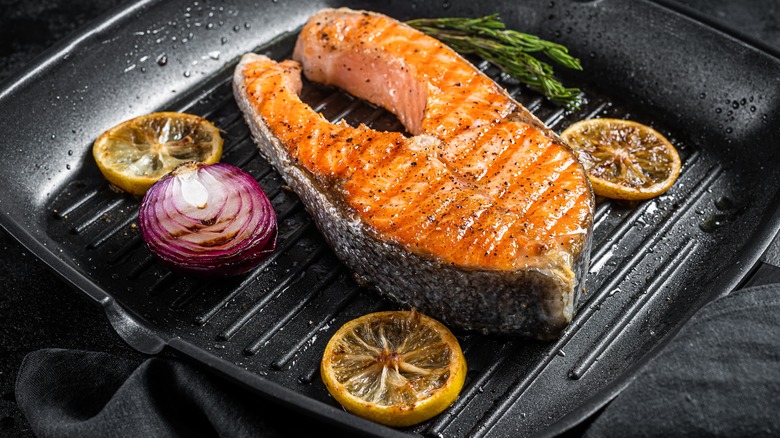How To Spot The Difference Between Salmon Steaks And Fillets
While a filet mignon is considered a steak, a fillet of salmon does not fall under the same umbrella as a salmon steak — the two are not one and the same. Salmon fillets are arguably much more popular than salmon steaks, but understanding the nuances between the two may have you choosing one over the other, depending on your preferences.
The difference between a salmon steak and a salmon fillet is how the meat is cut from the fish. The cut will directly affect its thickness. The fillet is cut from the side of the fish, and the steak is cut from a cross-section. For this reason, salmon fillets have a thick end and a more tapered end, whereas salmon steaks are more uniform in thickness.
While the two cuts differ in appearance, they do have slight differences when it comes to taste and the preferred cooking methods. Salmon steaks have a tad more powerful flavor, and are a bit more sturdy when it comes to cooking, thus making them a little more forgiving to work with. But overall, the two cuts are just about equals in these areas. If you're on the lookout for one over the other, there are a couple things to keep an eye out for.
Check for a bone and the thickness
A fillet cut from an animal simply means it is cut along the side of the animal parallel to its backbone. Just like how fillet mignon comes from the tenderloin of the cow (which runs next to the backbone), a salmon fillet comes from the flesh next to its spine. There are no large bones in a salmon fillet, just possibly small pin bones.
A salmon steak is cut perpendicular to the fish's backbone, cutting through its central bone. Steaks are usually cut from larger fish that are 10+ pounds. They are thicker than fillets and rounder in appearance, with a horseshoe shape resembling beef steak. The bone is often left in, but can be removed before you see it in the case or at a fishmonger. That being said, a good rule of thumb is that if you see a bone, it is salmon steak. Another rule of thumb is if you see skin surrounding the perimeter of the cut, it's a salmon steak — the skin is on the underside of the fillet.
Salmon steaks are firmer and thicker, and therefore less fragile than fillets, making them a great match for the grill or pan-searing. If you wish to substitute one for another in a recipe, just keep the cooking method in mind, as well as the overall flavor notes of the dish. Fillets are more delicate and have a slightly milder flavor than salmon steaks. Other than that, they're almost interchangeable.

